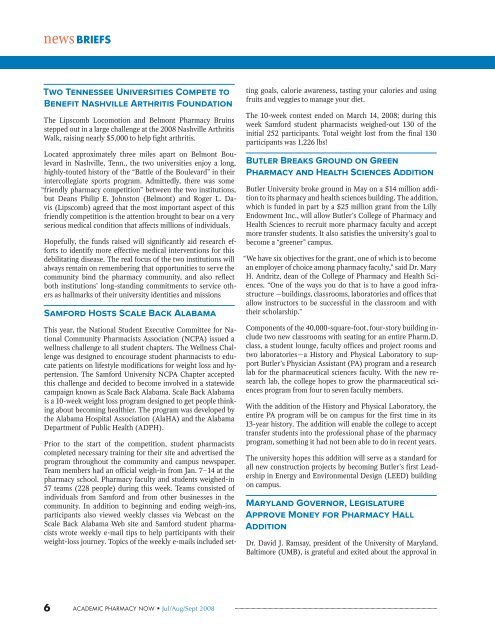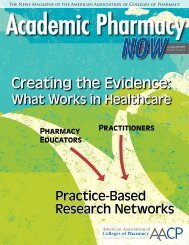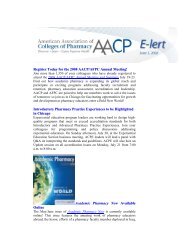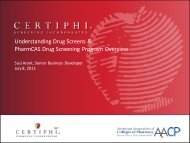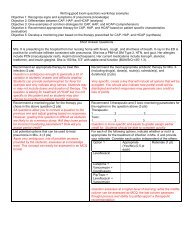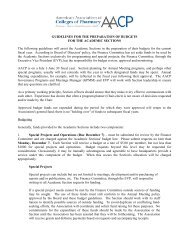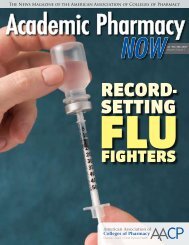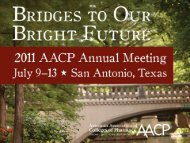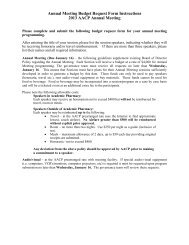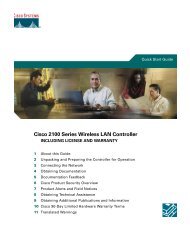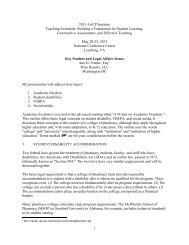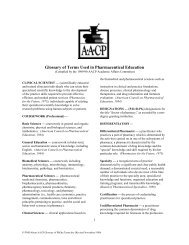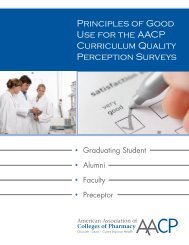Jul Aug 2008 APN.pdf - AACP
Jul Aug 2008 APN.pdf - AACP
Jul Aug 2008 APN.pdf - AACP
Create successful ePaper yourself
Turn your PDF publications into a flip-book with our unique Google optimized e-Paper software.
news b r i e f s<br />
Two Tennessee Universities Compete to<br />
Benefit Nashville Arthritis Foundation<br />
The Lipscomb Locomotion and Belmont Pharmacy Bruins<br />
stepped out in a large challenge at the <strong>2008</strong> Nashville Arthritis<br />
Walk, raising nearly $5,000 to help fight arthritis.<br />
Located approximately three miles apart on Belmont Boulevard<br />
in Nashville, Tenn., the two universities enjoy a long,<br />
highly-touted history of the “Battle of the Boulevard” in their<br />
intercollegiate sports program. Admittedly, there was some<br />
“friendly pharmacy competition” between the two institutions,<br />
but Deans Philip E. Johnston (Belmont) and Roger L. Davis<br />
(Lipscomb) agreed that the most important aspect of this<br />
friendly competition is the attention brought to bear on a very<br />
serious medical condition that affects millions of individuals.<br />
Hopefully, the funds raised will significantly aid research efforts<br />
to identify more effective medical interventions for this<br />
debilitating disease. The real focus of the two institutions will<br />
always remain on remembering that opportunities to serve the<br />
community bind the pharmacy community, and also reflect<br />
both institutions’ long-standing commitments to service others<br />
as hallmarks of their university identities and missions<br />
Samford Hosts Scale Back Alabama<br />
This year, the National Student Executive Committee for National<br />
Community Pharmacists Association (NCPA) issued a<br />
wellness challenge to all student chapters. The Wellness Challenge<br />
was designed to encourage student pharmacists to educate<br />
patients on lifestyle modifications for weight loss and hypertension.<br />
The Samford University NCPA Chapter accepted<br />
this challenge and decided to become involved in a statewide<br />
campaign known as Scale Back Alabama. Scale Back Alabama<br />
is a 10-week weight loss program designed to get people thinking<br />
about becoming healthier. The program was developed by<br />
the Alabama Hospital Association (AlaHA) and the Alabama<br />
Department of Public Health (ADPH).<br />
Prior to the start of the competition, student pharmacists<br />
completed necessary training for their site and advertised the<br />
program throughout the community and campus newspaper.<br />
Team members had an official weigh-in from Jan. 7–14 at the<br />
pharmacy school. Pharmacy faculty and students weighed-in<br />
57 teams (228 people) during this week. Teams consisted of<br />
individuals from Samford and from other businesses in the<br />
community. In addition to beginning and ending weigh-ins,<br />
participants also viewed weekly classes via Webcast on the<br />
Scale Back Alabama Web site and Samford student pharmacists<br />
wrote weekly e-mail tips to help participants with their<br />
weight-loss journey. Topics of the weekly e-mails included set-<br />
6<br />
academic Pharmacy now <strong>Jul</strong>/<strong>Aug</strong>/Sept <strong>2008</strong><br />
ting goals, calorie awareness, tasting your calories and using<br />
fruits and veggies to manage your diet.<br />
The 10-week contest ended on March 14, <strong>2008</strong>; during this<br />
week Samford student pharmacists weighed-out 130 of the<br />
initial 252 participants. Total weight lost from the final 130<br />
participants was 1,226 lbs!<br />
Butler Breaks Ground on Green<br />
Pharmacy and Health Sciences Addition<br />
Butler University broke ground in May on a $14 million addition<br />
to its pharmacy and health sciences building. The addition,<br />
which is funded in part by a $25 million grant from the Lilly<br />
Endowment Inc., will allow Butler’s College of Pharmacy and<br />
Health Sciences to recruit more pharmacy faculty and accept<br />
more transfer students. It also satisfies the university’s goal to<br />
become a “greener” campus.<br />
“We have six objectives for the grant, one of which is to become<br />
an employer of choice among pharmacy faculty,” said Dr. Mary<br />
H. Andritz, dean of the College of Pharmacy and Health Sciences.<br />
“One of the ways you do that is to have a good infrastructure<br />
—buildings, classrooms, laboratories and offices that<br />
allow instructors to be successful in the classroom and with<br />
their scholarship.”<br />
Components of the 40,000-square-foot, four-story building include<br />
two new classrooms with seating for an entire Pharm.D.<br />
class, a student lounge, faculty offices and project rooms and<br />
two laboratories—a History and Physical Laboratory to support<br />
Butler’s Physician Assistant (PA) program and a research<br />
lab for the pharmaceutical sciences faculty. With the new research<br />
lab, the college hopes to grow the pharmaceutical sciences<br />
program from four to seven faculty members.<br />
With the addition of the History and Physical Laboratory, the<br />
entire PA program will be on campus for the first time in its<br />
13-year history. The addition will enable the college to accept<br />
transfer students into the professional phase of the pharmacy<br />
program, something it had not been able to do in recent years.<br />
The university hopes this addition will serve as a standard for<br />
all new construction projects by becoming Butler’s first Leadership<br />
in Energy and Environmental Design (LEED) building<br />
on campus.<br />
Maryland Governor, Legislature<br />
Approve Money for Pharmacy Hall<br />
Addition<br />
Dr. David J. Ramsay, president of the University of Maryland,<br />
Baltimore (UMB), is grateful and exited about the approval in<br />
the state budget of funding for an addition to Pharmacy Hall at<br />
the University of Maryland School of Pharmacy.<br />
“In securing more than $62 million for the construction of the<br />
Pharmacy Hall addition, Gov. Martin O’Malley and the Maryland<br />
General Assembly have recognized the need to educate<br />
more pharmacists, carry out more cutting-edge research and<br />
deepen our commitment to serve the community,” said Ramsay.<br />
In response to a growing shortage of pharmacists, the School of<br />
Pharmacy has ratcheted up enrollment at the Baltimore campus<br />
to 120 students per class—more than it was designed to<br />
support—and last fall opened an expansion at the Universities<br />
at Shady Grove for 40 more students per class. The expansion<br />
will more comfortably allow it to take on additional students, as<br />
well as 40 percent more faculty in order to help meet the workforce<br />
shortage.<br />
The 92,635-square-foot, seven-story building will include lecture<br />
halls wired for computers and distance-learning technology,<br />
a new patient interaction laboratory, and four floors of space<br />
dedicated to clinical and translational research in pharmacogenetics,<br />
nanomedicine and drug discovery.<br />
The University of Maryland School of Pharmacy has spent more<br />
than a decade planning the addition, which should be open for<br />
the fall 2010 semester. The building designers will seek a silver<br />
LEEDs rating for the project upon completion. Energy efficient<br />
lighting fixtures and heat recovery air-handling systems are<br />
among the environmentally sensitive features planned for the<br />
building.<br />
“The Pharmacy Hall addition heralds a new era for the School<br />
of Pharmacy,” said Dr. Natalie D. Eddington, dean of the UM<br />
School of Pharmacy. “The additional space, technology and resources<br />
will ultimately help the next generation of students enter<br />
the professional world with all the interpersonal and scientific<br />
tools they will need.”<br />
CVS gives Howard University $300,000<br />
for lab upgrade<br />
Howard University and CVS opened the university’s newly upgraded<br />
Pharmacy Practice Laboratory, where pharmacy students<br />
can hone their skills in a practice setting, learning how to<br />
dispense medication, counsel patients and utilize the technology<br />
found in many pharmacies.<br />
CVS donated $300,000 to the renovation of the laboratory,<br />
building upon the company’s strong partnership with the school<br />
to provide enhanced educational and career opportunities.<br />
The Pharmacy Practice Laboratory houses 24 state-of-the-art<br />
workstations that allow students to gain experience in entering<br />
news b r i e f s<br />
and assessing patient-related information, such as health, allergy<br />
and medication history.<br />
The workstations also provide access to other technical support<br />
needed to ensure appropriate delivery of medications, patient<br />
counseling and medication therapy management. The laboratory<br />
is stocked with prescription and OTC medications, alternative<br />
medications, and home-testing devices so that students may<br />
practice dispensing and advising on medication and home tests.<br />
7th Annual APhA Self-Care Institute<br />
Prepares Tomorrow’s Pharmacists Today<br />
The growth of pharmacy-based patient care services is having<br />
a positive impact on the role of the pharmacist in managing<br />
self-treating patients. Not only is this growth increasing opportunities<br />
for practicing pharmacists, it is also shifting required<br />
competencies for graduating student pharmacists. Today’s<br />
pharmacy school graduates must be prepared to assess and educate<br />
self-treating patients regarding the use of nonprescription<br />
products and dietary supplements, the implementation of<br />
lifestyle modifications, as well as treatment with prescription<br />
medications.<br />
To help pharmacy school faculty better prepare the pharmacists<br />
of tomorrow, APhA hosted the seventh annual Self-Care<br />
Institute (SCI) in Chicago, June 19–22, <strong>2008</strong>. The 96 faculty<br />
attending the meeting were immersed in discussions of the latest<br />
self-care therapeutics information, regulatory and policy<br />
changes that affect self-care therapeutics, and strategies for<br />
incorporating this new information into existing pharmacy<br />
school curricula.<br />
By providing faculty with the information, tools, and strategies<br />
required for educating future pharmacists to deliver excellence<br />
in the care of self-treating patients, the SCI helps to support<br />
the future of this cost-effective health care delivery model.<br />
academic Pharmacy now <strong>Jul</strong>/<strong>Aug</strong>/Sept <strong>2008</strong> 7


